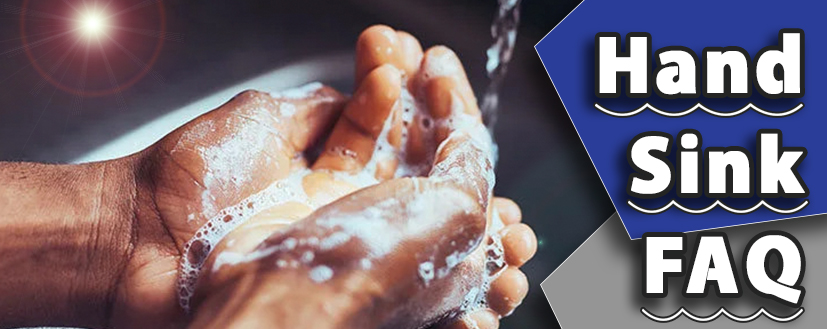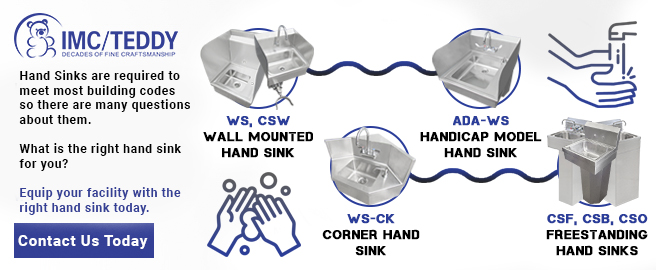Commonly Asked Questions About Hand Sinks

Hand sinks are a mandatory item in all commercial facilities. Each state regulation requires some form of hand sink to be installed for hygienic purposes. With that said, a hand sink is priority #1 for any establishment. However, choosing the right configuration (& model) can be a daunting task. IMC is here to shed some light on the subject.
In this article, we’ll go over the 4 most common questions we’ve received regarding hand sinks. We’ll provide valuable insight on some IMC models as well. Let’s start with the first question.
1. What is the Right Hand Sink Configuration for Me?
It’s the most general question, but there are several things to know before answering it correctly. The truth of the matter is hand sinks are not a “one size fits all” item. There are many factors to consider when choosing the right configuration. Ask yourself these questions first:
A. What is the layout of your water pipes/lines? If your lines are coming from the wall, consider a wall mounted hand sink with a splash mounted faucet. If the lines are coming from the floor, consider a free standing hand sink with a deck mounted faucet.
B. Are you trying to achieve a certain aesthetic for your area? Freestanding hand sinks are upscale while wall mounted hand sinks offer a more traditional look.
C. Where will it be installed? Consider the environment you are installing your hand sink (restaurant – back/front of house, medical, school, prison, etc.) If there is a large volume of people, consider multi-station sinks. If volume is low, single stations should suffice.
Once you know the answer to the above, the rest should fit right into place. However, other factors should be considered (more on these in the following questions).
2. Wall Mounted vs. Free Standing vs. Portable – Which Should I Look Into?
Before answering this, be sure to review your local codes as there may be a specific type of hand sink that is required in your facility. With that said, here is a brief rundown of all 3 types & what they are useful for:
A. Wall Mounted – As the name implies, the hand sink is attached to the wall via a Z-Clip. It’s the easiest to install & the most common type. The backsplash is standard; however the height of it will vary from product to product. Overall, it’s the basic choice that is great for most applications.
B. Free Standing – Free standing hand sinks are also installed via a Z-clip, but they include a pedestal. The pedestal includes a side panel for access to the plumbing. If you have the sufficient floor space, a free standing hand sink is a great option.
C. Portable – Portable hand sinks are better suited for mobile applications or areas where water lines are not available. Portable hand sinks can be shifted around your facility easily thanks to the casters. Best suited for outdoor events or temporary indoor areas.
3. What are ADA Regulations & What Hand Sink is Best?
ADA compliant equipment is needed to accommodate individuals with disabilities in all areas of public life. This means tailoring equipment to meet these specifications. With that said, hand sinks need a total revamp in look & function to meet the guidelines. Here are the ADA rules for hand sinks:
- Height: Sinks need to be mounted with the counter or rim no higher than 34″ above the finish floor.
- Knee Clearance: Knee clearance that is at least 27″ high, 30 in” wide, & 19″ deep needs to be provided underneath sinks.
- Depth: Each sink needs to be a maximum of 5” deep.
- Clear Floor Space: A clear floor space at least 30″ by 48″ needs to be provided in front of a sink to allow forward approach. The clear floor space must have an accessible route & extend a maximum of 19″ underneath the sink.
- Exposed Pipes & Surfaces: Hot water & drain pipes exposed under sinks must be insulated or otherwise configured so as to protect against contact. There must be no sharp or abrasive surfaces under the sink.
- Faucets: Faucets must be lever-operated, push-type, touch-type, or electronically controlled mechanisms. A faucet must be operable with one hand, with minimum force to control it.
- Soap Dispensers: Soap dispensers should be mounted at a maximum of 44” above the finished floor. Users should be able to operate the soap dispenser & faucet easily without obstruction.
IMC’s ADA hand sink fits all the above specifications with its stainless steel construction.
4. What Kind of Accessories Exist?
Apart from faucets & soap dispensers, several accessories exist for hand sinks. The most common one is a towel dispenser (again, several types exist). Another accessory is an eye wash station for use in emergency situations where flushing of the eyes is needed. Hand sinks can also be converted into fully hands free operation thanks to foot/knee pedals. Again, assess what your ultimate goal will be in installing hand sinks & fit in the accessories to support them.
IMC manufactures a full lineup of stainless steel hand sinks. They are 100% customizable & suited for all handwashing activities. For a closer look at IMC’s hand sinks, click here.




